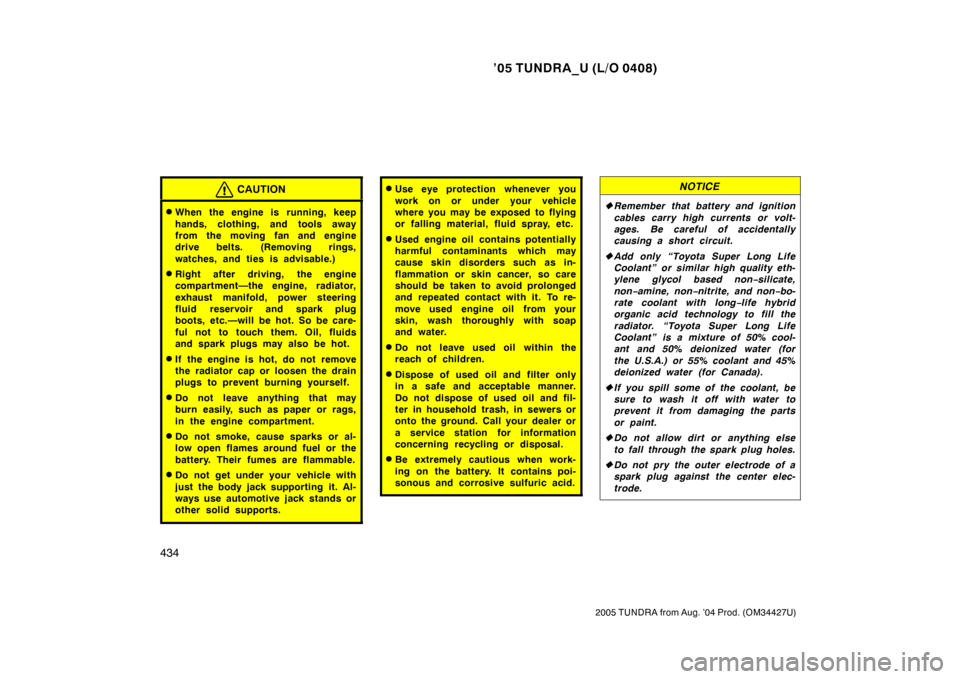Page 441 of 506
’05 TUNDRA_U (L/O 0408)
430
2005 TUNDRA from Aug. ’04 Prod. (OM34427U)
1. Power steering fluid reservoir
2. Engine oil level dipstick
3. Engine oil filler cap
4. Brake fluid reservoir
5. Fuse block
6. Battery
7. Engine coolant reservoir
8. Radiator
9. Condenser
10. Windshield washer fluid tank
Engine compartment overview
� 1GR −FE engine
Page 442 of 506
’05 TUNDRA_U (L/O 0408)
431
2005 TUNDRA from Aug. ’04 Prod. (OM34427U)
1. Power steering fluid reservoir
2. Engine oil level dipstick
3. Engine oil filler cap
4. Brake fluid reservoir
5. Fuse blocks
6. Battery
7. Engine coolant reservoir
8. Radiator
9. Condenser
10. Windshield washer fluid tank
�
2UZ− FE engine
Page 445 of 506

’05 TUNDRA_U (L/O 0408)
434
2005 TUNDRA from Aug. ’04 Prod. (OM34427U)
CAUTION
�When the engine is running, keep
hands, clothing, and tools away
from the moving fan and engine
drive belts. (Removing rings,
watches, and ties is advisable.)
�Right after driving, the engine
compartment—the engine, radiator,
exhaust manifold, power steering
fluid reservoir and spark plug
boots, etc.—will be hot. So be care-
ful not to touch them. Oil, fluids
and spark plugs may also be hot.
�If the engine is hot, do not remove
the radiator cap or loosen the drain
plugs to prevent burning yourself.
�Do not leave anything that may
burn easily, such as paper or rags,
in the engine compartment.
�Do not smoke, cause sparks or al-
low open flames around fuel or the
battery. Their fumes are flammable.
�Do not get under your vehicle with
just the body jack supporting it. Al-
ways use automotive jack stands or
other solid supports.
�Use eye protection whenever you
work on or under your vehicle
where you may be exposed to flying
or falling material, fluid spray, etc.
�Used engine oil contains potentially
harmful contaminants which may
cause skin disorders such as in-
flammation or skin cancer, so care
should be taken to avoid prolonged
and repeated contact with it. To re-
move used engine oil from your
skin, wash thoroughly with soap
and water.
�Do not leave used oil within the
reach of children.
�Dispose of used oil and filter only
in a safe and acceptable manner.
Do not dispose of used oil and fil-
ter in household trash, in sewers or
onto the ground. Call your dealer or
a service station for information
concerning recycling or disposal.
�Be extremely cautious when work-
ing on the battery. It contains poi-
sonous and corrosive sulfuric acid.
NOTICE
�Remember that battery and ignition
cables carry high currents or volt-
ages. Be careful of accidentally
causing a short circuit.
� Add only “Toyota Super Long Life
Coolant” or similar high quality eth-
ylene glycol based non −silicate,
non− amine, non −nitrite, and non −bo-
rate coolant with long −life hybrid
organic acid technology to fill the
radiator. “Toyota Super Long Life
Coolant” is a mixture of 50% cool-
ant and 50% deionized water (for
the U.S.A.) or 55% coolant and 45%
deionized water (for Canada).
� If you spill some of the coolant, be
sure to wash it off with water to
prevent it from damaging the parts
or paint.
� Do not allow dirt or anything else
to fall through the spark plug holes.
� Do not pry the outer electrode of a
spark plug against the center elec-
trode.
Page 446 of 506

’05 TUNDRA_U (L/O 0408)
435
2005 TUNDRA from Aug. ’04 Prod. (OM34427U)
�Use only spark plugs of the speci-
fied type. Using other types will
cause engine damage, loss of per-
formance or radio noise.
� Do not reuse iridium −tipped spark
plugs by cleaning or regapping.
� Do not overfill automatic transmis-
sion fluid, or the transmission
could be damaged.
� Do not drive with the air cleaner
filter removed, or excessive engine
wear could result. Also backfiring
could cause a fire in the engine
compartment.
� Be careful not to scratch the glass
surface with the wiper frame.
� When closing the engine hood,
check to see that you have not for-
gotten any tools, rags, etc.Here is a list of parts and tools you will
need to perform do− it−yourself mainte-
nance. Remember all Toyota parts are de-
signed in metric sizes, so your tools must
be metric.
CHECKING THE ENGINE OIL LEVEL
Parts (if level is low):
�“Toyota Genuine Motor Oil” or equiva-
lent
See Section 7 −2 for details about en-
gine oil selection.
Tools:
�Rag or paper towel
�Funnel (only for adding oil)
CHECKING THE ENGINE COOLANT
LEVEL
Parts (if level is low):
�“Toyota Super Long Life Coolant” or
similar high quality ethylene glycol
based non− silicate, non −amine, non− ni-
trite, and non −borate coolant with long−
life hybrid organic acid technology.
“Toyota Super Long Life Coolant” is a
mixture of 50% coolant and 50% deion-
ized water (for the U.S.A.) or 55%
coolant and 45% deionized water (for
Canada). Tools:
�Funnel (only for adding coolant)
CHECKING BRAKE FLUID
Parts (if level is low):
�SAE J1703 or FMVSS No.116 DOT 3
brake fluid
Tools:
�Rag or paper towel
�Funnel (only for adding fluid)
CHECKING POWER STEERING FLUID
Parts (if level is low):
�Automatic transmission fluid
DEXRON �II or III
Tools:
�Rag or paper towel
�Funnel (only for adding fluid)
CHECKING BATTERY CONDITION
Tools:
�Warm water
�Baking soda
�Grease
�Conventional wrench (for terminal
clamp bolts)
Parts and tools
Page 448 of 506

’05 TUNDRA_U (L/O 0408)
437
2005 TUNDRA from Aug. ’04 Prod. (OM34427U)
DO−IT −YOURSELF MAINTENANCE
Engine and Chassis
Checking the engine oil level 438
. . . . . . . . . . . . . . . . . . . . . . . . . . . . . . . . .
Checking the engine coolant level 440
. . . . . . . . . . . . . . . . . . . . . . . . . . . .
Checking the radiator and condenser 441
. . . . . . . . . . . . . . . . . . . . . . . . .
Checking brake fluid 442
. . . . . . . . . . . . . . . . . . . . . . . . . . . . . . . . . . . . \
. . . .
Checking power steering fluid 444
. . . . . . . . . . . . . . . . . . . . . . . . . . . . . . . .
Checking tire inflation pressure 444
. . . . . . . . . . . . . . . . . . . . . . . . . . . . . .
Checking and replacing tires 447
. . . . . . . . . . . . . . . . . . . . . . . . . . . . . . . . .
Rotating tires 449
. . . . . . . . . . . . . . . . . . . . . . . . . . . . . . . . . . . . \
. . . . . . . . . . .
Installing snow tires and chains 450
. . . . . . . . . . . . . . . . . . . . . . . . . . . . . .
Replacing wheels 452
. . . . . . . . . . . . . . . . . . . . . . . . . . . . . . . . . . . . \
. . . . . . .
Aluminum wheel precautions 452
. . . . . . . . . . . . . . . . . . . . . . . . . . . . . . . .
SECTION 7− 2
Page 455 of 506

’05 TUNDRA_U (L/O 0408)
444
2005 TUNDRA from Aug. ’04 Prod. (OM34427U)
If hot O.K. Close Open
If cold O.K.
If hot add If cold add
Check the fluid level through the reser-
voir. If necessary, add automatic trans-
mission fluid DEXRON �II or III.
If the vehicle has been driven around 80
km/h (50 mph) for 20 minutes (a little
more in frigid temperatures), the fluid is
hot (60 �C—80 �C or 140 �F—175 �F). You
may also check the level when the fluid
is cold (about room temperature,
10 �C—30 �C or 50 �F—85 �F) if the engine
has not been run for about five hours. Clean all dirt from the outside of the res-
ervoir tank and look at the fluid level. If
the fluid is cold, the level should be in the
“COLD” range. Similarly, if it is hot, the
fluid level should be in the “HOT” range.
If the level is at the low side of either
range, add automatic transmission fluid
DEXRON
�II or III to bring the level within
the range.
To remove the reservoir cap, turn it coun-
terclockwise and lift up. To reinstall it,
turn it clockwise. After replacing the reser-
voir cap, visually check the steering box
case, vane pump and hose connections
for leaks or damage.
CAUTION
The reservoir tank may be hot so be
careful not to burn yourself.
NOTICE
Avoid overfilling, or the power steer-
ing could be damaged.
Standard and double cab models
Checking power steering fluid Checking tire inflation
pressure
Page 488 of 506

’05 TUNDRA_U (L/O 0408)
477
2005 TUNDRA from Aug. ’04 Prod. (OM34427U)
Recommended oil viscosity:
FrontSAE 75W −90
Rear Standard differential
Synthetic oil SAE 75W −140
Limited− slip differential
Above −18 �C (0 �F)
SAE 90
Below −18 �C (0 �F)
SAE 80W or 80W −90
CHASSIS LUBRICATION
(Four −wheel drive models)
Propeller shafts: SpidersLithium base chassis grease, NLGI
No.2
Double cardan joint Molybdenum −disulfide lithium base
chassis grease, NLGI No.2
Slide yokes Lithium base chassis grease, NLGI
No.2 or Molybdenum −disulfide lithium
base chassis grease, NLGI No.2 BRAKES
Minimum pedal clearance when depressed
with the force of 490 N (50 kgf, 110 lbf)
with the engine running, mm (in.):
Without vehicle stability control system95 (3.7)
With vehicle stability control system 80 (3.1)
Pedal free play, mm (in.): 1—6 (0.04—0.24)
Pad wear limit, mm (in.): 1.0 (0.04)
Lining wear limit, mm (in.): 1.0 (0.04)
Parking brake adjustment: Pedal type—when depressed with the
force of 300 N (30.6 kgf, 67.1 lbf)8—10 clicks
Lever type—when pulled with the force
of 200 N (20.4 kgf, 45 lbf) 8—12 clicks
Fluid type: SAE J1703 or FMVSS No.116 DOT 3 STEERING
Wheel free play:
Less than 30 mm (1.2 in.)
Power steering fluid type: Automatic transmission fluid DEXRON �II
or III